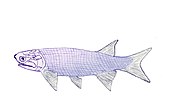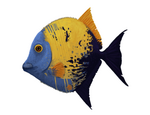Hulettia: Difference between revisions
Rescuing 1 sources and tagging 0 as dead.) #IABot (v2.0 |
Open access status updates in citations with OAbot #oabot |
||
| (24 intermediate revisions by 16 users not shown) | |||
| Line 1: | Line 1: | ||
{{Short description|Extinct genus of ray-finned fishes}} |
|||
{{Italic title}} |
|||
{{Automatic taxobox |
|||
{{Taxobox |
|||
| ⚫ | |||
| ⚫ | |||
| image = Pholidophorus americanus NMNH-USNM4788A.jpg |
|||
| image = File:Hulettia_Fossil,_from_NewMexicoMuseum.png |
|||
| image_caption = |
| image_caption = Type specimen |
||
| ⚫ | |||
| ⚫ | |||
| authority = Patterson, 1984 |
|||
| regnum = [[Animalia]] |
|||
| ⚫ | |||
| phylum = [[Chordate|Chordata]] |
|||
| type_species_authority = Eastman, 1899 |
|||
| subphylum = [[Vertebrate|Vertebrata]] |
|||
| subdivision_ranks = Other species |
|||
| infraphylum = [[Gnathostomata]] |
|||
| subdivision = *{{extinct}}''H. hawesi'' <small>Kirkland, 1997</small> |
|||
| superclassis = [[Osteichthyes]] |
|||
| classis = [[Actinopterygii]] |
|||
| subclassis = [[Chondrostei]] |
|||
| ordo = [[Palaeonisciformes]]<ref>{{cite web |url=http://paleodb.org/cgi-bin/bridge.pl?a=checkTaxonInfo&taxon_no=34963&is_real_user=1 |title=Palaeonisciformes |publisher=Paleobiology Database |accessdate=November 17, 2012}}</ref> |
|||
| superfamilia = |
|||
| familia = |
|||
| subfamilia = |
|||
| genus = '''''Hulettia''''' |
|||
| ⚫ | |||
| binomial = |
|||
| binomial_authority = |
|||
}} |
}} |
||
'''''Hulettia''''' is an extinct genus of [[ray-finned fish]] known from [[United States]]. This fish [[genus]] contains two species, ''H. americana'' and ''H. hawesi''. |
|||
'''''Hulettia''''' is an extinct genus of prehistoric [[bony fish]] found in the [[Morrison Formation]] in the western [[United States]], measuring approximately three to four inches in length. This fish [[genus]] contains one species, ''H. americana''. Its body was covered in thick prominent scales, and its name is based on [[Hulett, Wyoming]], a locale which is near the [[Morrison Formation]]. Discovered specimens show evidence of predation upon the smaller species of fish [[Todiltia]] that inhabited the Jurassic Lake Todilto, and another specimen discovered in the [[Bathonian]] coastal sandstone, in the [[Sundance Formation]] of [[South Dakota]]. Both specimens are complete skeletons with no fragmentary remains or dubious anomalies amongst the bones recovered.<ref>http://fossilworks.org/cgi-bin/bridge.pl?a=taxonInfo&taxon_no=212144 C. R. Eastman. 1899. Jurassic fishes from Black Hills of South Dakota. Geological Society America Bulletin 10:397-408 9/22/14</ref> |
|||
== |
== Species == |
||
The type species, ''H. americana'' is originally described as a species of ''[[Pholidophorus]]'' in 1899.<ref>[https://paleobiodb.org/classic/checkTaxonInfo?taxon_no=212144] C. R. Eastman. 1899. Jurassic fishes from Black Hills of South Dakota. Geological Society America Bulletin 10:397-408 9/22/14</ref> In 1984, its own genus name ''Hulettia'' is given, after [[Hulett, Wyoming]]. Holotype is known from [[Sundance Formation]] of [[South Dakota]], while other specimens are also known from [[Wanakah Formation|Wanakah (Summerville) Formation]], [[Todilto Formation]] and [[Ralston Creek Formation]].<ref name=":0">{{Cite book |last1=Schaeffer |first1=Bobb |url=https://www.biodiversitylibrary.org/bibliography/197680 |title=Jurassic fishes from the western United States, with comments on Jurassic fish distribution |last2=Schaeffer |first2=Bobb |last3=Patterson |first3=Colin |date=1984 |publisher=American Museum of Natural History |location=New York, N.Y}}</ref><ref name=":1">{{Cite book |last1=Kirkland |first1=D. W. |url=http://dx.doi.org/10.58799/b-147 |title=Middle Jurassic Todilto Formation of northern New Mexico and southwestern Colorado: Marine or nonmarine? |last2=Denison |first2=R. E. |last3=Evans |first3=R. |date=1995 |publisher=New Mexico Bureau of Geology and Mineral Resources|doi=10.58799/b-147 }}</ref> |
|||
It lived in an [[ecological niche]] similar to minnows and other small forage fish. The most noticeable quality of the ''Hulettia'' is its extremely durable and compact scales, providing protection from [[lepidophagy]], external parasites and predation by fish which could not swallow it whole.<ref>http://earthphysicsteaching.homestead.com/Jurassic_Fossil_Fish.html Hulettia; Guadalupe County</ref> It prominently fed upon smaller fish, shrimp and other crustaceans, gastropods, worms and aquatic insect nymphs. Its mouth was lined with short tiny teeth that could scrape algae and other plant matter from solid surfaces, suggesting that it was an opportunistic forager that didn't solely depend on ingesting smaller creatures.<ref>http://nmnaturalhistory.org/hulettia.html {{Webarchive|url=https://web.archive.org/web/20140908065351/http://nmnaturalhistory.org/hulettia.html |date=2014-09-08 }} New Mexico Museum of Natural History, |
|||
| ⚫ | |||
Second species, ''H. hawesi'' is described from [[Morrison Formation]] of Colorado. This species is named after William Hawes who found the holotype.<ref name=":2">{{Cite journal |last=Kirkland |first=James I. |date=1998 |title=Morrison fishes |url=https://www.researchgate.net/publication/292223569 |journal=Modern Geology |volume=22 |pages=503–533}}</ref> |
|||
==Natural Threats & Uranium Deposits== |
|||
''Hulettia'', after reaching their maximum size of {{convert|4|in|cm}}, had no threats from predators other than each other, or [[Todiltia]] which inhabited the same ecosystem (which could only prey upon the fry of ''Hulettia'',) making it one of the smallest [[apex predator]]s to ever exist during the [[Jurassic]]. In spite of the commonness of [[piscivorous]] [[Jurassic]] [[birds]], large [[ammonite]]s and marine reptiles ([[Pliosauridae|pliosaurs]] and [[Ichthyosauria|Ichthyosaurs]]), the environment in which Hulettia and [[Todiltia]] inhabited were completely devoid of any [[fossils]] of the respective carnivores. It is believed that the colossal deposits of [[Uranium]] that are found in [[Todilto Formation]] and the [[Morrison Formation]] deterred other organisms from the area, and isolated the two species, protecting them from predation and trophic competition until their disappearance from the fossil record in the [[Cretaceous]].<ref>https://nmgs.nmt.edu/publications/guidebooks/downloads/54/54_p0179_p0189.pdf New Mexico Geological Society Guidebook, 54th Field Conference, Geology of the Zuni Plateau, 2003, p. 179-189.</ref> |
|||
''H. americana'' reached their maximum standard length (excluding fins) of {{convert|15.5|cm|in}}, while ''H. hawesi'' is much smaller, with standard length of {{convert|5.85|cm|in}} (about {{convert|7.2|cm|in}} total length).<ref name=":0" /><ref name=":2" /> |
|||
== Classification == |
|||
At 1984, it was classified as [[Halecostomi]] ''[[incertae sedis]]''.<ref name=":0" /> Later study shows that is likely a member of [[Neopterygii]], pan-[[holostean]].<ref>{{Cite journal |last1=Near |first1=Thomas J. |last2=Thacker |first2=Christine E. |date=2024-04-18 |title=Phylogenetic Classification of Living and Fossil Ray-Finned Fishes (Actinopterygii) |journal=Bulletin of the Peabody Museum of Natural History |volume=65 |issue=1 |doi=10.3374/014.065.0101 |issn=0079-032X|doi-access=free |url=https://zenodo.org/records/8352027/files/Near%26Thacker_preprint.pdf }}</ref> |
|||
== Paleoecology == |
|||
Formations that ''H. americana'' known are considered as [[Ocean|marine]] environment,<ref name=":1" /> while Morrison Formation where ''H. hawesi'' described shows freshwater environment.<ref name=":2" /> Discovered specimens show evidence of predation upon the smaller species of fish ''[[Todiltia]]''.<ref>http://nmnaturalhistory.org/hulettia.html {{Webarchive|url=https://web.archive.org/web/20140908065351/http://nmnaturalhistory.org/hulettia.html|date=2014-09-08}} New Mexico Museum of Natural History, |
|||
| ⚫ | |||
==See also== |
==See also== |
||
| Line 43: | Line 40: | ||
* [https://web.archive.org/web/20080430004102/http://strata.ummp.lsa.umich.edu/jack/showgenera.php?taxon=611&rank=class Bony fish in the online Sepkoski Database] |
* [https://web.archive.org/web/20080430004102/http://strata.ummp.lsa.umich.edu/jack/showgenera.php?taxon=611&rank=class Bony fish in the online Sepkoski Database] |
||
{{Neopterygii}} |
|||
{{Taxonbar|from=Q5935653}} |
{{Taxonbar|from=Q5935653}} |
||
[[Category: |
[[Category:Prehistoric neopterygii]] |
||
[[Category:Morrison fauna]] |
[[Category:Morrison fauna]] |
||
Latest revision as of 02:49, 11 December 2024
| Hulettia Temporal range:
| |
|---|---|

| |
| Type specimen | |
| Scientific classification | |
| Domain: | Eukaryota |
| Kingdom: | Animalia |
| Phylum: | Chordata |
| Class: | Actinopterygii |
| Subclass: | Neopterygii |
| Genus: | †Hulettia Patterson, 1984 |
| Type species | |
| Hulettia americana Eastman, 1899
| |
| Other species | |
| |
Hulettia is an extinct genus of ray-finned fish known from United States. This fish genus contains two species, H. americana and H. hawesi.
Species
[edit]The type species, H. americana is originally described as a species of Pholidophorus in 1899.[1] In 1984, its own genus name Hulettia is given, after Hulett, Wyoming. Holotype is known from Sundance Formation of South Dakota, while other specimens are also known from Wanakah (Summerville) Formation, Todilto Formation and Ralston Creek Formation.[2][3]
Second species, H. hawesi is described from Morrison Formation of Colorado. This species is named after William Hawes who found the holotype.[4]
H. americana reached their maximum standard length (excluding fins) of 15.5 centimetres (6.1 in), while H. hawesi is much smaller, with standard length of 5.85 centimetres (2.30 in) (about 7.2 centimetres (2.8 in) total length).[2][4]
Classification
[edit]At 1984, it was classified as Halecostomi incertae sedis.[2] Later study shows that is likely a member of Neopterygii, pan-holostean.[5]
Paleoecology
[edit]Formations that H. americana known are considered as marine environment,[3] while Morrison Formation where H. hawesi described shows freshwater environment.[4] Discovered specimens show evidence of predation upon the smaller species of fish Todiltia.[6]
See also
[edit]References
[edit]- ^ [1] C. R. Eastman. 1899. Jurassic fishes from Black Hills of South Dakota. Geological Society America Bulletin 10:397-408 9/22/14
- ^ a b c Schaeffer, Bobb; Schaeffer, Bobb; Patterson, Colin (1984). Jurassic fishes from the western United States, with comments on Jurassic fish distribution. New York, N.Y: American Museum of Natural History.
- ^ a b Kirkland, D. W.; Denison, R. E.; Evans, R. (1995). Middle Jurassic Todilto Formation of northern New Mexico and southwestern Colorado: Marine or nonmarine?. New Mexico Bureau of Geology and Mineral Resources. doi:10.58799/b-147.
- ^ a b c Kirkland, James I. (1998). "Morrison fishes". Modern Geology. 22: 503–533.
- ^ Near, Thomas J.; Thacker, Christine E. (2024-04-18). "Phylogenetic Classification of Living and Fossil Ray-Finned Fishes (Actinopterygii)" (PDF). Bulletin of the Peabody Museum of Natural History. 65 (1). doi:10.3374/014.065.0101. ISSN 0079-032X.
- ^ http://nmnaturalhistory.org/hulettia.html Archived 2014-09-08 at the Wayback Machine New Mexico Museum of Natural History, 1999





